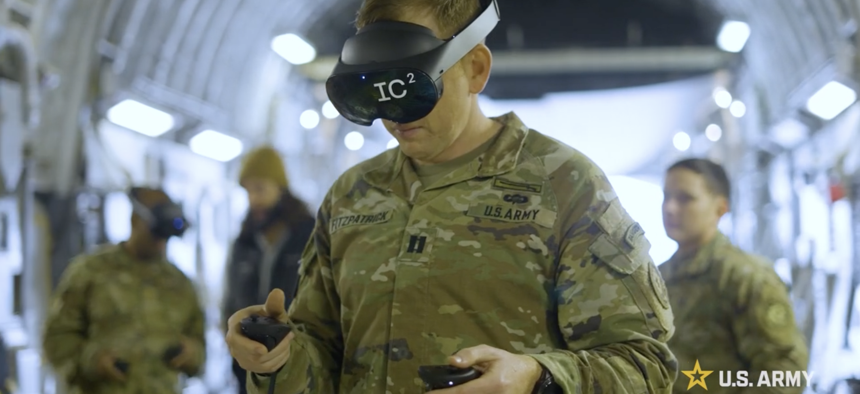SAM SKOVE

As the Army chief of staff pushes to put more experimental tech into the hands of average soldiers, two brigades at opposite ends of the globe are already pressing forward on everything from commercial drones to translation apps.
One—the 2nd Infantry Brigade Combat Team, or IBCT, of the Hawaii-based 25th Infantry Division—is putting commercial drones at the core of every operation, a program that got a boost in the Army’s recent budget submission.
The other—the Europe-based 2nd Cavalry Regiment—is experimenting with cutting-edge software and other tech, including virtual reality, that increases units’ ability to survive on a modern battlefield.
The 2nd Cav’s work has even become a template for the broader transformation that Gen. Randy George wants to see in the Army.
The regimental commander “understands the challenges of large-scale combat operations and is adapting in real time to be more mobile, low-signature, and lethal,” the chief of staff said in his October AUSA address.
Out in Hawaii, 2nd IBCT commander Col. Graham White has been seeding drones across his unit for the last year.
The division is “really baking [small drones] into our culture,” White said. “For all maneuver training we do in the 25th Infantry Division,” White said, “that all now includes [small drone] employment.”
He said soldiers from logistics to infantry are trained on the use of commercial drones by the brigade’s helicopter pilots in a two-day course. They get additional practice flying the drones on the units’ ranges. Finding the area to fly drones without violating airspace regulations has been a challenge for Army units.
To sharpen his soldiers’ skills, White has also worked small drones into existing competitions to hone flight and visual recognition abilities. For example, soldiers competing in events like a rope climb or a marksmanship challenge might have to use a drone to identify a sniper hiding in a fake village.
Soldiers particularly love drone races that require navigation or reading text placed in hard-to-access places. “That’s a popular one, because it requires skill with a joystick,”, White said.
The unit operates around 12 drones representing four models from the Defense Department Blue UAS list, White said. His soldiers have found that a wide variety of drones, including longer-range fixed-wing, shorter-range, quadcopters, and a mix of sensors is required.
White encourages use of the drones, even if that means they are accidentally damaged in training.
“We are not putting incredibly stringent measures in place as it pertains to soldiers’ employment on those platforms,” White said. “We do realize they're gonna break in, and we do realize that we'll buy more.”
White pays for the drones out of his operations budget, a fund of several hundred thousand dollars more typically used for training and other needs. White said that drone purchases had to be built into the budget: “I need to make it a priority for it to occur,” he said.
With drones off the Blue UAS list costing more than the average commercial, Chinese-made drone, White wishes that drone prices would come down, though. Drone purchases could run to a quarter of his budget he said, comprising his largest spending category for any singular item.
“We don’t have the amount we need right now,” he said.
At least some relief may be coming: in the Army’s unfunded priority list for the fiscal year 2025 budget is a request for $25 million in commercial drone spending. That money will go straight into operation and maintenance accounts, service officials said last week, which may make it easier for unit commanders to acquire drones.
In Europe
Thousands of miles away in Germany, the 2nd Cavalry regiment is also experimenting with adding in more commercial tech as well.
In one December exercise, 2nd Cavalry units had communications set up from the moment their vehicles rolled off transport planes thanks to commercial satellite services, said 2nd Cavalry Regiment commander Col. Robert McChrystal.
The unit also experimented with a virtual command post accessed via augmented reality goggles, from Palantir’s Immersive Command and Control, or IC2. Using the sets allowed units separated by hundreds of miles to look at the same screens as if they were in the same room, said McChrystal.
McChrystal’s unit has experimented with using other tech to make decision processes faster, including testing automatic translation software from Microsoft Azure. The software was used in an exercise with Poland and France and worked well, he said.
“We had a [French] battalion underneath us, and then we had a Polish division over the top of us,” he said.
That software was spread to other European units by loading the software onto Samsung phones held by liaison officers, said Maj. Jaime Holm, fire support officer for the 2nd Cavalry Regiment. “We could host a meeting where you speak into it in English and to the Polish user, it comes out in Polish.”
The unit will also test out battle simulation software that can help units in the field game out what areas to attack or where to defend.
The idea in principle is not new; armies have run table-top exercises since at least the 1800s to game out what an enemy might do in a given situation.
Unlike the wood-blocks and paper maps of yore, though, the software will provide answers in minutes and pull in live data, said Holm. “We can find ways to use predictive tools that help our current processes run faster,” said Holm.
As the two brigades move forward with their trials, Pentagon leaders and other offices in the Defense Department are watching and helping, according to the 2nd Cav leaders.
“We are routinely asked by army senior leaders — how they can help, and what systems and procurement methods are working or not working,” White said. “The battlefield is changing quickly — we're going to risk irrelevance if we don't change with it.”
No comments:
Post a Comment